We visited Tasmania in 2014 on our first trip around the world, and fell in love with it. You could call us Tasmaniacs. Naturally, on this trip we had to go back.
Itinerary:
- Days 1-4: Hobart and surrounds (day trips to Maria Island, Port Arthur and hiking Mount Wellington)
- Days 5-8: Bicheno (including Bay of Fires, Colomba Falls, and Freycinet National Park)
- Days 9-11: Stanley, Fern Glade Reserve, and Tarkine Wilderness
- Days 12-16: Cradle Mountain
- Days 17-18: Bruny Island
- Day 19: Fly out
Dates: March 31 – April 18, 2018
Our Odyssey:
It’s not often that we get the opportunity to visit the same international destination more than once. After all, with limited time to see the world, it’s hard to justify revisiting a place unless you have friends or family living there.
This reality made our second trip to Tasmania that much more special. We’d visited in 2014 on our first round-the-world trip for a week and fell in love. It was our favorite place in Australia that we’d visited (and we’d traveled the country pretty extensively from our Sydney to Cairns road trip, visiting Melbourne, and hopping up to Alice Springs and Uluru). We decided then that we needed to come back and spend more time there.
With three weeks in Tasmania on this trip, we had plenty of time to make a slow road trip around the island state below the Australian mainland. Long the butt of many jokes about being backwards and “bogan” (Australian for redneck), Tasmania is now a trendy travel destination. Now it’s known for farm to table food, tons of hiking, and excellent wildlife spotting opportunities. This tourism boom happened after our first visit, when it was just on the cusp of becoming a mainstream destination.
When we arrived at the Hobart Airport after a long travel itinerary coming from Fiji, we were exhausted. We wouldn’t be able to check into our Airbnb until the afternoon, though, so we picked up our rental car (which we got for free for the full 19 days using our Chase Ultimate Rewards points) and found a grocery store parking lot to nap in.
Since we didn’t spend anytime in or around Hobart on our first visit, we decided to make this our base for the first few nights. Hobart is Tasmania’s capital city, but being Tassie (as the locals call it), it’s still pretty small.

Pretty streets of Hobart
After we checked in to our house, we just relaxed and got to bed early. The next day we headed out to visit Port Arthur, about an hour and a half south east of Hobart proper. Although the historic site of the old Port Arthur Penitentiary settlement was our primary destination for the day, we made several stops along the way. The first was the Tessellated Pavement, an area of rocky shoreline where the magic of water erosion and salt has left straight lines crossing the rock forming perfect-looking rectangular engravings. The lines are so exact, they look man-made.

Checking out the Tessellated Pavements

Checking out the Tessellated Pavements

I loved the reflections on the Tessellated Pavements!
From there we made it to Eaglehawk Neck, a thin strip of land that connects the Tasman Peninsula. The spot is home to a fascinating history. On the southern end was the Penitentiary, and towards the north, freedom. To guard against would-be escapees, this strip of land was monitored by soldiers and vicious dogs who were kept hungry and trained to attack. The only other escape route was a precarious sea journey, so not very many people succeeded in escaping the prison.
Next we were on to the main event – visiting the grounds of the historic penitentiary itself. If you’ve followed us for a while, you know I have an attraction to the darker side of history. From the Jack the Ripper murders in London to ghost hunting in Idaho’s old state penitentiary, the grim, gruesome and paranormal never cease to fascinate me. So of course visiting an old prison, its haunted parsonage, and Isle of the Dead cemetery was my idea of a good time.
When we arrived we opted to buy a combo ticket that included a tour of the main penitentiary and the Isle of the Dead. They also had options that included a visit to the grounds of the Point Puer Boys Prison, but to do all three you would need a full day. We thought the cemetery sounded the most interesting, and, come on, it was named the ISLE OF THE DEAD.
The penal colony was established in 1830 as a place where repeat offenders were sent from England to reform and imprison the convicts. As you may already know, England colonized Australia primarily with inmates and the military who guarded them. Tasmania in particular was a harsh place to send the prisoners, situated seemingly at the end of the world with cold and windy weather.

Port Arthur Prison Complex as seen from the harbor cruise

Main penitentiary at Port Arthur
By 1840, more than 2000 people lived here. Though no new prisoners arrived after 1853, ex-convicts who had served their time stayed. Going back home was too far a trip, and nothing was left for them there anyway. Port Arthur became a welfare camp, housing those too sick or old to go anywhere else. During this time a separate prison opened as a “lunatic asylum” where the ultimate goal was mental reform, treating the patients with kindness, and providing a clean and calm environment. However, patients were still required to complete prisoners’ work alongside one another; their disturbing behavior, allegedly, shattered any hope of a calm environment.
Aside from the prison itself, there were quarters for the soldiers, a church, a parsonage, hospital and other buildings typical for any small village or community.

The old church

View from near the commandant’s house
When visiting Port Arthur, your ticket includes a guided introductory tour of the main grounds as well as a harbor cruise. If you also buy a ticket to either the Isle of the Dead or Point Puer, this harbor cruise will drop you off on whichever of the two islands you’re visiting with a guide who will take you around and tell you about the interesting history. You cannot visit either without a guide.
Because of the timing when we arrived, our harbor cruise and tour of the Isle of the Dead cemetery were before our grounds tour. The harbor cruise itself is pretty dry, and honestly unless you’re doing one of the island tours I would probably skip it and spend more time exploring the grounds. The Isle of the Dead, though, was very interesting. It’s a small island and the whole thing is a cemetery where prisoners, soldiers and their families were buried.

Isle of the Dead
We didn’t visit Point Puer, but did see it during the cruise. This was the site of a boys prison, for young men between 14-17. The intent was to keep them separated from the bad influences of the older men in the main prison, in hopes of reforming them and teaching them a trade so they can reenter society productively.
Back on the mainland, Tim and I joined our introductory tour and then explored the grounds a bit on our own. The most interesting building to me was the solitary confinement prison, where even the church pews inside were divided in such a way inmates could file into their spots without ever seeing each other. The ruins of the church and the neighboring (and haunted) parsonage were also fascinating. The grounds are huge and you are welcome to explore almost everything. You can easily spend hours here- and we did.

In solitary confinement, even the church pew seats were divided so prisoners would never see each other.
The next day we again ventured out a little bit beyond Hobart for a day trip to Maria Island, northeast of the city and accessible by ferry from mainland Tasmania. Maria Island is famous for its wildlife (you’re all but guaranteed to see kangaroos and wombats) and good short hikes from the ferry drop off. There are no cars allowed on the island and aside from a small backpacker lodge and the remnants of the old penitentiary buildings that were here, it’s all nature.

Wide open spaces on Maria Island
We did the two most popular walks here. First we set out to see the Fossil Cliffs. The path cuts through high coastal fields where Forester kangaroos laze around in the sun. It’s a short walk to the cliffs where you can see thousands of fossilized shells 300 million years old.

Can you spot the fossils?
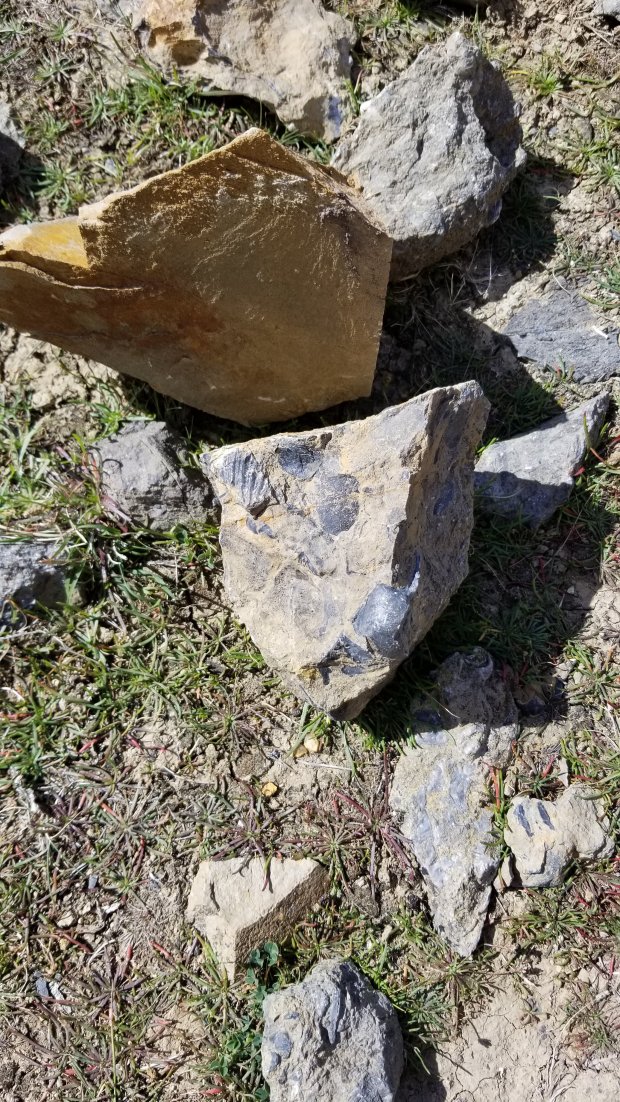
Can you spot the fossils?

Can you spot the fossils?

Tim walking through the quarry
From there the path leads to beautiful sheer cliffs with big sea views before cutting inland through a forest. In the forest we saw our first wombat of the day! Wombats look, in my opinion, like giant guinea pigs. They are super fluffy and super cute.

Hellooo wombat!!
Eventually the trail arrives into the “town” of Darlington. This is where the old historic buildings are. Heading south from here you can visit the Painted Cliffs, so-called for the red and orange marble patterns on the sandstone. Walking back towards the boat pick up point from there, we saw many wombats, leisurely nibbling on grass, completely unconcerned with people. This was definitely the best wombat watching we’ve ever done. The ones we had seen on our first trip to Tasmania were further away and much less abundant.

Painted Cliffs
We ended up doing everything we wanted earlier than our ferry time but thankfully we were able to hop on the earlier one. We probably spent about 4 hours total on Maria.
We had another relaxing evening at our place in Hobart, cooking food and watching TV. It’s funny how the mundane can be so enjoyable when you’re on the go a lot.
The next day we stayed closer to Hobart and did some hiking around Mt. Wellington. We parked the car at the Organ Pipe track, which was already a good ways up the mountain, and started walking. This part of the path goes by steep cliffs whose rocks look like the pipes on an organ. It’s mostly flat until you get to a stunning viewpoint over the city and beyond. You can even see Port Arthur from there. At this point the trail joins up with the steep but relatively short Zig Zag track that leads to the summit of the mountain. The views, and the wind, are impressive. There is a car park and visitor center at the top, so we sat inside away from the wind eat lunch before taking the Panorama trail back down to the car, basically completing a large 3 hour loop around the mountain.

Trying not to panic over how high up I was

Big views at the start of the Zig Zag trail

Tim looking out over Hobart

Organ Pipes
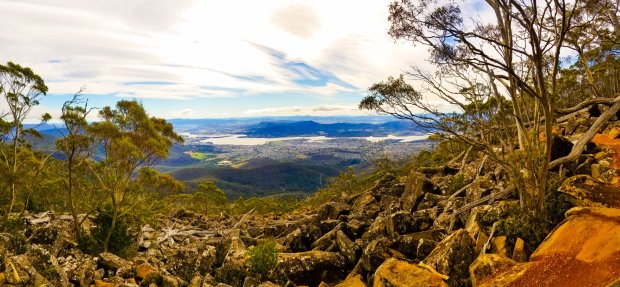
Stunning day on Mount Wellington
We had the rest of the afternoon to relax back at our place, perfect for our last night staying in Hobart.
The next morning (Wednesday), we visited the Museum of Old and New Art in our way out of town. Tim and I aren’t “artsy” people, and most of the time when we look at art, we can’t figure out what it means. This museum is a great example. They have a machine that makes poop, a pan with a fish and a knife in it, and a room playing videos of people singing Madonna songs. It was fun and fascinating to explore, but admittedly I don’t have any deep thoughts about what it all “meant”.

Art
From there we headed straight to Bicheno, a place that captured our hearts when we visited in 2014. We even stayed at the same Airbnb as before. Bicheno is a lovely little coastal town, and every evening fairy penguins come ashore to nest.

Our adorable Airbnb
The next day we headed to Freycinet National Park, with the goal being to hike the same loop by the famous Wineglass Bay and Hazards Beach we had hiked before. Somehow, even though we did this once before, we made a wrong turn and ended up walking a half hour along Wineglass Beach thinking it was another beach. This added about an hour to our hike – oops! We laughed that at least we got to see something new as a result! The hike itself is fantastic. Tasmania’s coastline of fiery orange rocks contrasting against the azure water is simply beautiful to see. The perfect beaches and occasional wallaby are pretty awesome too!

Wineglass Bay

Wineglass Beach

Wineglass Beach

On the trail to Hazards Beach

New buddy we met at Wineglass Bay

At one of the many picturesque coves along the trail to Hazards Beach

Stunning light coming into the forested part of the trail
The next day we headed up further north along the east coast for a day trip to check out the famous Bay of Fires. We followed our directions on Google maps and signs along the way, but we think we must have missed the main part of the Bay of Fires that people love so much. All we found was a small area of very orange rocks against the water. It was pretty for sure, but no more so than anything else along the east coast. Yet, people rave about it. We think maybe we went to the wrong spot. *Shrug emoji*.

Bay of Fires

Bay of Fires
From the Bay of Fires we headed inland to see St. Colomba Falls, the tallest waterfall in Tasmania. We stopped for a beer at a small country pub (Pub in the Paddock) and for cheese tasting at a dairy farm. The cheese was definitely my favorite part, and we bought two kinds to bring back to our Airbnb.
The next day was a “day off” – meaning we intentionally do nothing. They’re great days. We lazed around watching TV and eating cheese, venturing out only to visit the Bicheno blow hole, where water rushes up in between the rocks and explodes in geyser-like fashion. It’s a lot of fun because you never know when or how big the splash will be!

Bicheno Blowhole
That night we also headed outside in search of penguins. We found many hanging out among the rocks, squawking away. They are so beautiful, and the experience brought me back to that night in 2014 (which happened to be Halloween) when we were sitting on that couch, heard that distinctive penguin call, and immediately grabbed the red light flashlights to try to spot them. We must have seen several dozen that night.
From Bicheno we headed way west to the town of Stanley on the north coast. It was mostly a driving day, but when we got in, we explored a little bit. We headed up to a hill overlooking the ocean and the town just in time for sunset. We drove past a cow farm and stopped to take photos of them against the sunset. We don’t know why but as we were standing there with the fence between us and the cows, they all started walking towards us in unison. It was very creepy!

Creepy cows
Since we were close, we then went to Highfield, an historic homesteading property from the 1800s. It was technically closed but the gate was open so Tim and I walked in to explore the outside of the old buildings and get views of The Nut, Stanley’s most distinctive landmark. The Nut is actually the 12-million-year old core of an extinct volcano and sits prominently like a smaller Ayer’s Rock/Uluru over the town.

The Nut

Highfield Homestead

Highfield Homestead
The next morning we walked the steep sides of the Nut up to its flat top, where we explored the 2km loop trail. Aside from the beach views, we also saw wallabies and pademelons (basically extra tiny wallabies) sleeping in bushes.

Lifts up the Nut
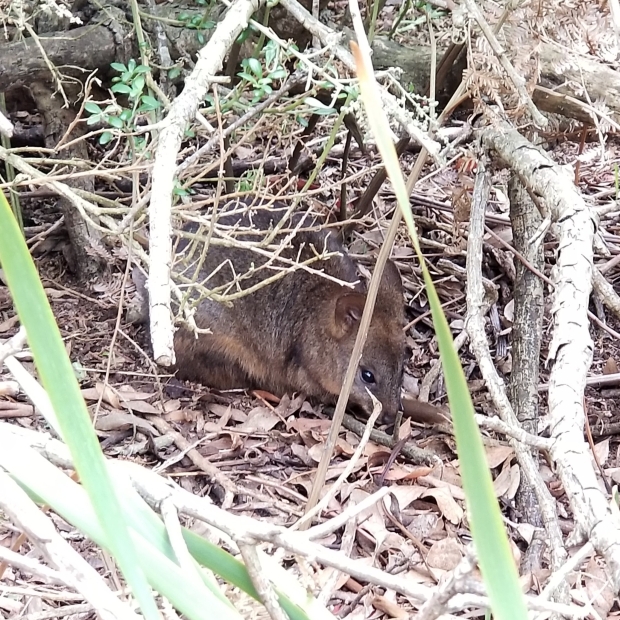
Pademelon
Afterwards we drove east from Stanley to Rocky Cape National Park. A small coastal park, it’s also home to ancient aboriginal caves that you can see from the trails. We opted to do the short North and South cave trails, as well as the longer Banksia Grove/Caves Circuit trail at the other end of the park.

Rocky Cape National Park
After a shameless stop at a Pizza Hut for a snack, we headed to Fernglade Reserve, which I’d read is one of the most reliable places to see the elusive platypus in the wild. With a bill and webbed feet like a duck and a body like a beaver and eggs like a bird or reptile, these mammals are an evolutionary wonder.
When we first came to Tasmania in 2014, we tried to spot them, but it turns out if you don’t know where (water) and when (late afternoon) to look or even what to look for (something like a beaver gliding across the water), you probably won’t have much luck.
Unsure what we’d find there, we started out on the trail by the river. We met the cutest, friendliest white duck at the trail start. He followed us around and stared up at us with curiosity. I always love those organic moments where you and an animal are mutually aware of one another, even if it is just a common duck.
We meandered slowly down the trail without seeing anything that could be a platypus. At one of the lookout points, we met a woman who is actually a resident platypus expert. She was the one who designed and wrote all the information signs around the reserve. She told us that if you spend at least an hour here, you’re all but guaranteed to spot one.
With renewed confidence, we continued the search. Still nothing for another half hour. It was beginning to darken so we decided to get going. At the start of the trail where we had met our duck friend we paused for one last look out over the river. I saw a glimpse of a splash in the water, and excitedly told Tim. We stared in that direction and sure enough, a platypus was swimming along the surface in the direction from which we’d just come. We got to observe this weird little animal for about 10 minutes before we lost him or her. Beyond excited about our luck, we headed back to the car and even got to say goodbye to our little duck friend before heading off!
Our next stop was a rather random one. We’d met some people earlier in Tasmania and they’d invited us to this magic show event at a farm. We had mulled wine and good conversation, but didn’t stay long since we were pretty tired.
The next day we ventured south of Stanley to the Tarkine Wilderness for a scenic drive that encompassed both coast and forest. My favorite stop happened to be the first – Trowutta Arch. A short trail meanders through a lush, green forest. On either side of the path are countless mushrooms, many of which were kinds and colors I’d never seen before. With your eyes constantly scanning the ground for the next specimen of fascinating fungi, you’ll be shocked when you reach the end of the trail and finally look up. Before you is an arch that perfectly frames a sunlit gorge.

Trowutta Arch
We spent the rest of the day visiting the sinkholes and rivers in the Tarkine forest before heading to the coast. The coastal portion was not nearly as well-marked, and incredibly windy. The wind was so strong, the white caps of the waves dissipated in the gusts before ever crashing. Looking out west from the aptly named “Edge of the World”, the next piece of land is South America.

The Edge of the World
That night at our Airbnb, we had another wildlife encounter – one we really didn’t want. While watching TV, I caught a rat scurry across the living room from the kitchen out of the corner of my eye. I shrieked and told Tim. Immediately we were on the prowl looking for the big fella. We saw him dart back into the kitchen where we set up a barricade to hopefully keep him in place. We didn’t see him again the rest of the night.
Stories like this can often dissuade people from using services like Airbnb, but I can assure you this has never happened before. Additionally, it’s a true testament to the customer service you receive from Airbnb that our host refunded us part of our stay, and Airbnb gave us a credit to use on a future booking.
The next day we had a short drive to Cradle Mountain National Park, where we would stay for 5 nights. We had visited for a few hours in 2014, but wanted to come back and have time to do some proper hiking around the jagged and elusive Cradle Mountain. The area is almost always shrouded in clouds, but when we arrived, it was surprisingly clear outside. After a quick stop at the visitor center, we headed to Dove Lake to see the mountain (which we didn’t see at all in 2014 due to dense fog) and take some photos in case it didn’t appear again the rest of our stay.

View of Cradle Mountain from Dove Lake
Sure enough, the next day was rainy. We took the opportunity to relax and plan for our big hike to summit Cradle Mountain the next day (Friday), which was forecasted to have decent weather.
We ended up getting really lucky on our hike, with perfectly clear skies most of the morning. The walk starts from the Dove Lake car park and heads up pretty steadily past Lake Lilla and the smaller lake Wombat Pool, and then the larger Crater Lake. After about two hours we reached the magnificent Marion’s Lookout, which gives you a full-frontal view of the mountain and a bird’s eye view over Dove Lake.

Cradle Mountain
Though it was somewhat cloudy when we arrived, it cleared up completely shortly after, and stayed clear for most of our walk to the base of the summit climb.
I’m not sure what we were expecting in climbing a mountain, but this part of the trail was incredibly scrambly, requiring full-body climbing for 45 minutes over large rocks to reach the summit. We made it just 5 minutes shy of the true summit when we decided we were in over our heads. It was getting misty outside, making the rocks more slippery, and the last portion of the climb was on the face of a relatively steep drop. Given the risks, and the fact that with so much cloud cover we wouldn’t see anything from the summit anyway, we decided to turn around there, proud of ourselves for climbing as far as we did and still knowing when to play it safe.

Cradle Mountain Views
After the equally scrambly descent back down to the main trail, we continued on to the Face Track trail. We enjoyed lunch PB&Js overlooking Dove Lake, with Cradle Mountain looming behind us.
The next part of the trail seemed ill-maintained. The wooden pieces were broken off the path and strewn about the muddy ground. We had the option to take a longer but more gradual way around via the Lake Rodway trail, but instead decided to take the steep Lake Wilks trail down to the popular and mostly paved path that loops Dove Lake.

Descending the Mountain
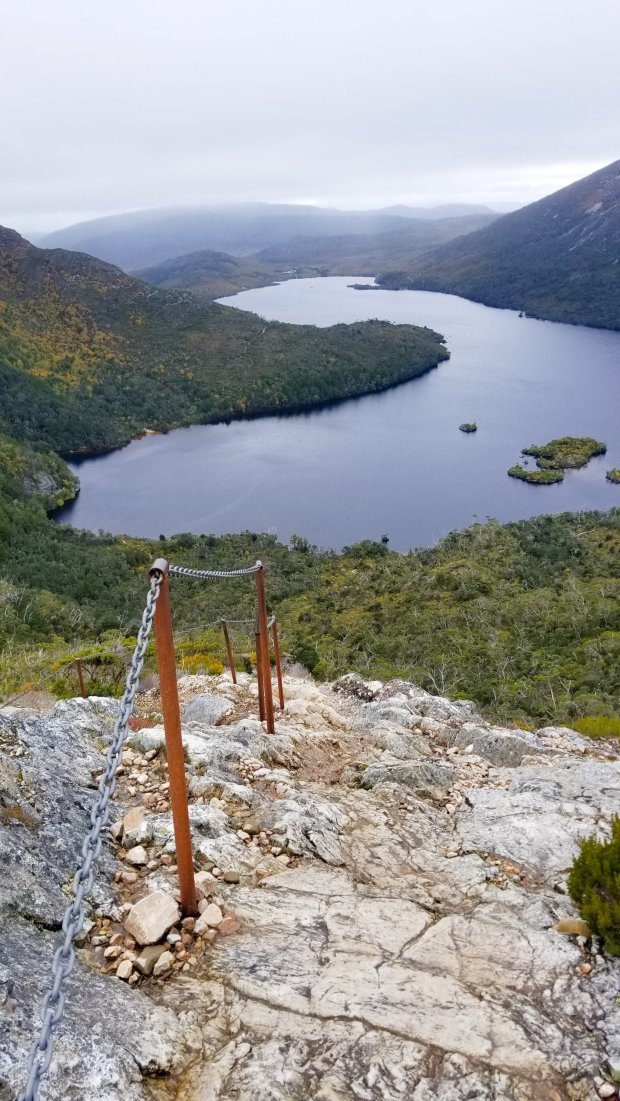
Super steep descent on Lake Wilks Trail
After scrambling down more steep rocks with the help of a chain, the trail wanders through the forest for a while. By this point my legs were exhausted from the climbing and my steps were getting sloppy. I was so happy when we got to the paved trail!
Overall, we hiked 8 fun and challenging miles in mostly good weather. This was especially lucky given that it rained the rest of our time in Cradle Mountain, and even thunder snowed one night.
Thus, we spent the rest of our time there relaxing. We did venture out to visit a sanctuary for the endangered Tasmanian devils (Devils@Cradle), which was an amazing way to spend an hour. Tasmanian devils are at risk in the wild due to a contagious face cancer. The breeding program at the sanctuary aims to create an “insurance population” with healthy genes that can resist the disease in the wild. They have a similar program for quolls, which look like bigger, spotted ferrets, kind of.

Quoll

Tasmanian Devil
After many leisurely days, we drove to our last destination in Tasmania before flying way west to Perth for our west coast road trip- Bruny Island.
Bruny Island is south of Hobart, and you have to take a ferry to get there. Bruny is remote, picturesque, and the only home to rare white (albino) wallabies since they have no natural predators there.
When we arrived to our Airbnb, a white wallaby was already waiting for us in the yard! He looked like the white rabbit from Alice in Wonderland, sitting on his haunches with his round belly sticking out. Soon, several brown wallabies came by as well. At one point, there were six of them hanging out in the yard, looking cute and winning my heart. If we had done nothing else on Bruny Island, this experience alone would have been worth it.

Rare white wallaby
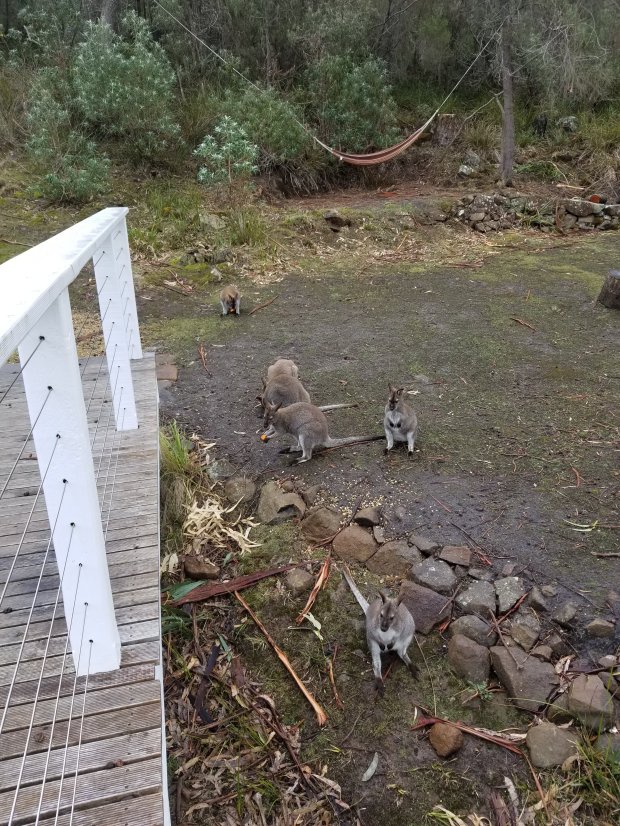
So many wallabies in the yard!
The next morning though, we did make sure we got out to explore! We started with a hike along the dramatic coastline on the Fluted Cape trail, and then headed towards the northern half of the island to check out some of Bruny’s culinary delights. First up was beer and cheese tasting at the aptly named Bruny Island Beer and Cheese , followed by oysters at Get Shucked and ending with some honey at a little shack on the main road.

Fluted Cape Walk
The next morning we had to head back into Hobart to catch our flight. It was surreal to think that this time we probably won’t be coming back. After all, visiting such a remote place twice is rare as is, and the chances of me and Tim returning to Australia are low. That said, Tasmania will always have a piece of our hearts. I hope our adventure will inspire you to visit as well!


This has made me very home sick, great post.
LikeLiked by 1 person
❤️❤️ It’s such an incredible place. Thank you for reading!
LikeLike
I can only hope that I find somewhere that beckons to me in my travels. I would really love to go back to Dartmoor, England. It was my favorite part of my England trip.
-Knurly
LikeLiked by 1 person
That’s awesome! I’ve never been to Dartmoor – honestly I’ve only really explored London in England, but I want to go back and do a big trip around the UK!
LikeLiked by 1 person
I think it’s worth a visit. Stone circles everywhere.
LikeLiked by 1 person
Ooooo!! 😍
LikeLiked by 1 person
Hey there! Thanks for linking through to ‘Fork and Foot’ – much appreciated! Looks like you had a fantastic Tasmanian experience. It’s great that you could spend so much time there, as so many people only allow a day or two.
If you’re looking for coffee in Antigua I think we may have you sorted as well 😀 Best of luck with the Spanish lessons, Antigua is the perfect place for it! Hopefully Fuego keeps a lid on things while you’re there (we were there during the eruptions earlier this year!)…
Cheers,
Andrew and Karen.
LikeLike
We love Tasmania, and we definitely have you guys to thank for sharing your route on the Mount Wellington hike!
I’ll check your site for your Antigua recs! I do enjoy good coffee ☕ I can’t imagine being there during the eruptions 😳if you guys wrote about it on your blog, drop the link, I’d love to read!
LikeLike
The views from some of the coffee shops are sensational as you’re surrounded by the three massive volcanoes! You’ll love it I’m sure 🙂
No articles, but we’ve got a few pics on our FB page. It was such a strange experience. We thought it was raining at first but couldn’t work out why we weren’t getting wet. Turns out it was ash and grit falling from the sky!! 😳
LikeLike
Wow, that had to have been such a strange experience!
LikeLike